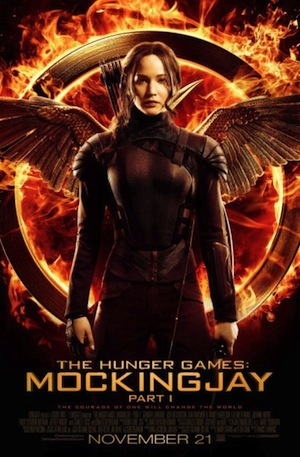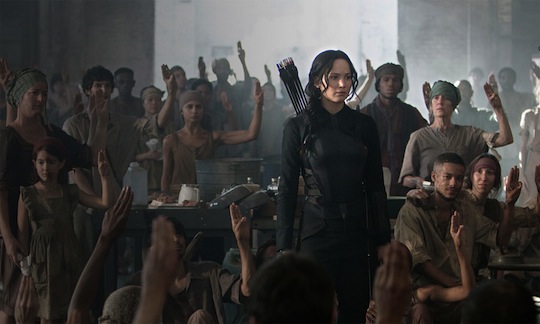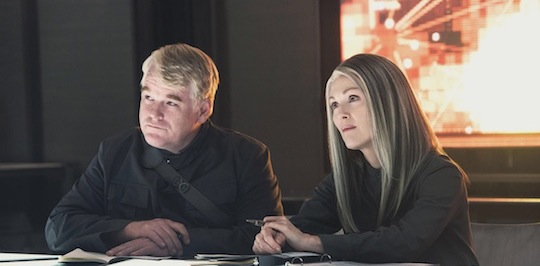 [Rating: Minor Rock Fist Down]
[Rating: Minor Rock Fist Down]
This review appears at Lawrence.com.
The first thing I thought coming out of The Hunger Games: Mockingjay — Part 1 is that it isn’t much of a movie.
I don’t mean that the production isn’t professional or that it doesn’t look like a movie — it just doesn’t feel like one. It’s the worst recent example of Hollywood serialization — a victim of its own success.
What I mean is that it isn’t satisfying in any way.
It’s no news to fans of the young-adult book series by Suzanne Collins that this third movie only covers a portion of her third novel, which is par for the course, I suppose, for a film that contains a both a colon and a hyphen in its title. But even in the Star Wars series, which now retroactively features the word “Episode” in each title, the films themselves had a form of resolution. Sometimes there were cliffhangers, sure, but the emotional journey and theme of each film were wrapped up by film’s end.
Then again, George Lucas wasn’t adapting someone else’s novel.
To adapt the 759-page Harry Potter and the Deathly Hallows, Warner Bros. spilt the film version into two parts. There was just too much plot to cram into one movie, and 2010’s Deathly Hallows Part 1 ended up being one of the most effective Potter films, partially because it elucidated the gravity of its characters’ situation and gave them breathing room.
Peter Jackson is the most recent offender of Hollywood serialization, of course, turning the 300-page The Hobbit into three films totaling seven and a half hours, but he’s also using supplemental material from J.R.R. Tolkien’s other writings to fill that out.
Ironically, with The Hunger Games: Mockingjay — Part 1 (a 390-page book), letting the characters breathe turns out to be a really bad idea. Not only does it expose how one-dimensional most of its characters are but it also reinforces the idea that Jennifer Lawrence has been doing most of the heavy lifting throughout these films and shows what little she had to work with this time out.
As designed, Mockingjay — Part 1 is visually the most drab of the movies so far because very little of it takes place in the candy-colored Capitol, where the prevailing fashion sense is for its uber-rich citizens to out-peacock each other. Instead, Katniss Everdeen (Lawrence) has been taken underground to District 13, where the rebels walk around in olive-green, prison-like jumpsuits and eat awful food in cafeterias together.
From a plot standpoint, it’s refreshing to see Mockingjay — Part 1 jettison the setup/gameplay formula of The Hunger Games and Catching Fire, but what little forward movement there is in the film has our resourceful hero Katniss sidelined, while talented actors like Julianne Moore and the late Philip Seymour Hoffman phone it in.
They play the leaders of the resistance, which means they do three things mainly: call meetings, look at screens and make speeches. (Remember all of that Galactic Senate speechifying in The Phantom Menace? Now that’s something to aspire to.)
The media satire of the first two films has shifted from reality-TV culture to the nature of propaganda. Rather than fighting, Katniss has become a symbol to unite the districts against the Capitol.
The only way to make her a truly effective propaganda tool is to put her in the field where she can witness the horror of the war against the districts firsthand, and the camera can capture her rage. She complies. On the other side, President Snow (Donald Sutherland) uses Peeta (Josh Hutcherson) to talk the rebelling districts down.
What unites all three movies is that their lite satire revolves around the manufacturing of authenticity. It’s not a terribly profound media criticism, but at least The Hunger Games is about something bigger — while it distracts its audience with the requisite dopey love triangle (will she choose the werewolf or the vampire?) and life-or-death gameplay (a bloodless Battle Royale).
In Mockingjay — Part 1, none of that window dressing exists. Katniss, the lightning rod, that symbol of young female empowerment, is reduced to a person of inaction.
The revolution has sprouted up around her and it continues on, without her participation. She’s reduced to battling her own feelings for Gale (poor Liam Hemsworth, with nothing to do) and Peeta, and weighing her personal life against the greater good of all of Panem. Neither of these conflicts are particularly effective and both of them are counter to the forward movement of the story.
Besides being padded with scenes that go on too long and drive home the same story beat that’s already been established, Mockingjay — Part 1 is just plain dull. There is only one major plot revelation in the entire movie, and it’s obvious from the outset. Meanwhile, time that’s supposed to be spent deepening the relationship between Katniss and Gale is completely unconvincing.
Neither of first two The Hunger Games movies were perfect, but at least they were built on a structure with a certain amount of proven success in the drama department. Good on Collins for trying something new this time out (and to the screenwriters for a valiant attempt at adapting a third of it, as instructed), but Mockingjay — Part 1 is a wholly unsatisfying movie. Whether it’s redeemed by Part 2 remains to be seen, but at this point, I couldn’t be any less interested in finding out.










Comments on this entry are closed.